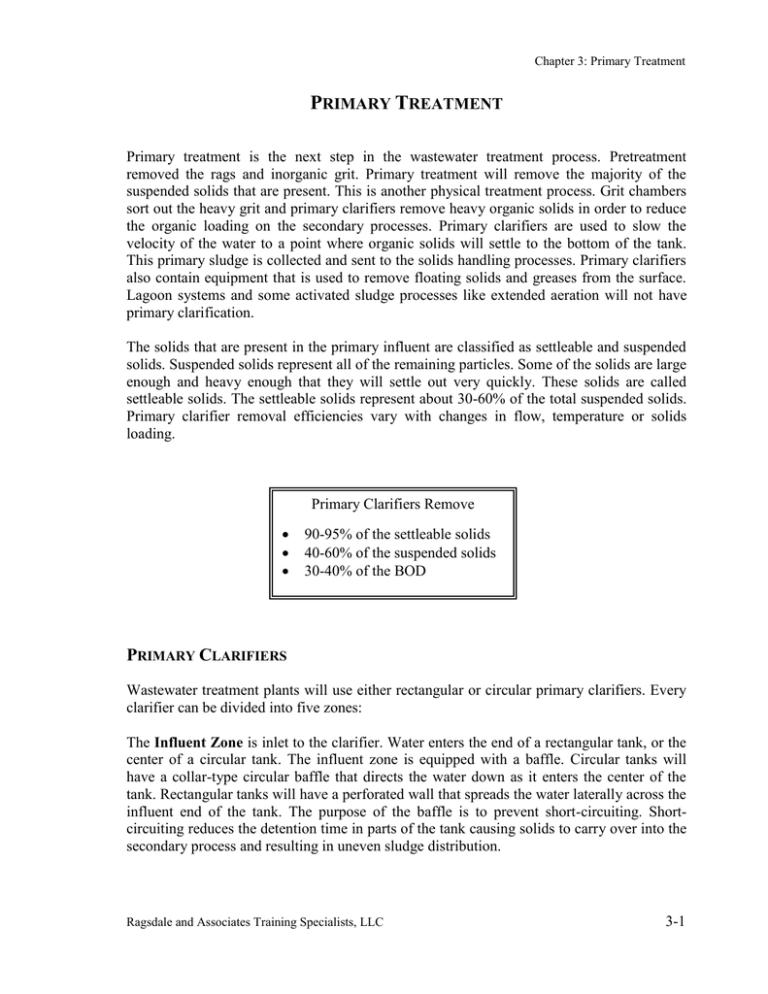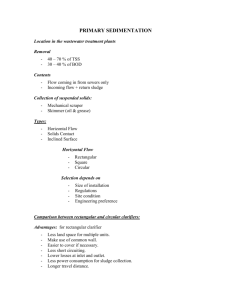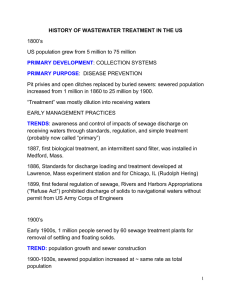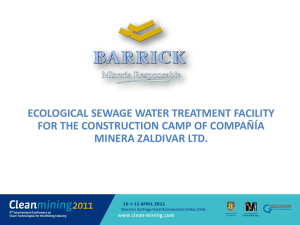P T RIMARY
advertisement

Chapter 3: Primary Treatment PRIMARY TREATMENT Primary treatment is the next step in the wastewater treatment process. Pretreatment removed the rags and inorganic grit. Primary treatment will remove the majority of the suspended solids that are present. This is another physical treatment process. Grit chambers sort out the heavy grit and primary clarifiers remove heavy organic solids in order to reduce the organic loading on the secondary processes. Primary clarifiers are used to slow the velocity of the water to a point where organic solids will settle to the bottom of the tank. This primary sludge is collected and sent to the solids handling processes. Primary clarifiers also contain equipment that is used to remove floating solids and greases from the surface. Lagoon systems and some activated sludge processes like extended aeration will not have primary clarification. The solids that are present in the primary influent are classified as settleable and suspended solids. Suspended solids represent all of the remaining particles. Some of the solids are large enough and heavy enough that they will settle out very quickly. These solids are called settleable solids. The settleable solids represent about 30-60% of the total suspended solids. Primary clarifier removal efficiencies vary with changes in flow, temperature or solids loading. Primary Clarifiers Remove 90-95% of the settleable solids 40-60% of the suspended solids 30-40% of the BOD PRIMARY CLARIFIERS Wastewater treatment plants will use either rectangular or circular primary clarifiers. Every clarifier can be divided into five zones: The Influent Zone is inlet to the clarifier. Water enters the end of a rectangular tank, or the center of a circular tank. The influent zone is equipped with a baffle. Circular tanks will have a collar-type circular baffle that directs the water down as it enters the center of the tank. Rectangular tanks will have a perforated wall that spreads the water laterally across the influent end of the tank. The purpose of the baffle is to prevent short-circuiting. Shortcircuiting reduces the detention time in parts of the tank causing solids to carry over into the secondary process and resulting in uneven sludge distribution. Ragsdale and Associates Training Specialists, LLC 3-1 Chapter 3: Primary Treatment The Settling Zone represents the largest portion of the tank. The water velocity is reduced to 0.03-0.05 fps and the detention time should be about 2 hours. The problem is that the flow rises and falls during a 24-hour period. As the flow increases the detention time decreases. Slowing the water down for this long allows the sludge to settle to the bottom while the water is removed from the top of the tank. Clarifiers are usually only about 8-12 feet deep and have a surface loading rate of about 800-1400 gpd/sq ft. This keeps the upward velocity of the water low enough to minimize solids carryover. The Skimming Zone is at the surface of the tank. Solids and greases that have a specific gravity of less than 1.0 will float to the surface of the clarifier. A skimmer arm is attached to the rake assembly. It skims the surface as the rake rotates. In a rectangular tank the sludge rakes act as skimmers when the chain brings them to the surface. Floating scum is deposited in a grease or scum hopper. This grease and scum must be properly landfilled to prevent odor problems. 3-2 Ragsdale and Associates Training Specialists, LLC Chapter 3: Primary Treatment The Effluent Zone is the part of the tank where the settled water leaves to go to the secondary treatment processes. In rectangular tanks the water leaves at the end opposite the influent. In circular or square tanks the water leaves at the edge of the tank. A channel called the effluent launder collects the effluent flow and directs it to the effluent piping. Weirs are installed along the edge of the effluent launder to skim the water evenly off the surface of the tank. The most common type of effluent weir is a V-notch (or saw-tooth) weir. A Vnotch weir is a plate that has notches, about 2-3 inches deep, cut in it every 6-8 inches. If the weir is clean and level, it will remove water evenly all the way around the edge of the tank. This minimizes the upward velocities near the effluent launder and improves removal efficiencies. If the weir plate is not level, or part of the weir becomes clogged with slime or debris, shortcircuiting will result because more water will pass over the low side or the clean notches of the weir. Short-circuiting will cause poor settling and uneven sludge blanket buildup. A baffle plate, a ring 6-8 inches inside the weir, is installed to prevent floating solids from going over the weir. The design criterion for weirs is the weir overflow rate. The weir overflow rate establishes how many gallons can pass over each foot of weir each day. The standard weir overflow rate is between 20,000-25,000 gpd/ft. The Sludge Zone is the bottom of the tank where the settled sludge collects and compacts. Sludge blanket depth should be measured and sludge should be removed at least every shift. Sludge rakes push the sludge to one end or the center of the tank so that it can be pumped out. The rake drive is usually equipped with a torque indicator. The torque indicator resembles the indicator on a torque wrench. A needle moves across a graduated scale that indicates how much force is needed to move the rake through the sludge. If too much torque is applied, a shear pin in the drive shaft will break to prevent damage to the gearbox or drive shaft. A fluctuating torque reading indicates uneven sludge buildup in the sludge zone. Short-circuiting in the unit causes this uneven distribution of sludge. Failure to remove sludge often enough will result in anaerobic conditions and gas buildup in the sludge. The sludge can become septic, releasing gas bubbles, and float to the top where it can be difficult to remove. It can also result in increased odor problems. The sludge rake moves sludge to the sump located in the center of the tank. Ragsdale and Associates Training Specialists, LLC 3-3 Chapter 3: Primary Treatment PRIMARY SLUDGE PUMPING Primary sludges must be removed frequently in order to minimize odor problems and prevent sludge from going septic. Septic sludges are much more difficult to thicken or dewater. The frequency depends on solids handling capability, solids and hydraulic loading, and pumping capacity. Sludge is usually removed every 2-4 hours. Primary sludge pumps are positive-displacement pumps. The pumping cycles must be designed to provide the thickest sludge possible. This is a balancing act between allowing the sludge to concentrate and removing it before it turns septic or creates too much load on the rake mechanism. Primary sludge normally averages 46% solids. Pumping large amounts of sludge over a short period of time can create a hole in the sludge blanket and drop the solids concentration in the sludge dramatically. SECONDARY CLARIFIERS There are minor differences between primary and secondary clarifiers. Secondary clarifiers may not have skimming equipment. The sludge removal equipment may also be different in activated sludge processes. Secondary sludges have lower solids concentrations. Trickling filter sludge will be 1.5-2.0% solids and return activated sludge will be about 0.5-0.8% solids. The solids inventory in activated sludge clarifiers can impact SVI and MLSS results and must be taken into account. When sludge sits in the secondary clarifier too long, denitrification can occur. Nitrogen gas will be released, causing the same rising sludge problems that occur in primary clarifiers. The sludge from activated sludge clarifiers must be removed continuously. This Return Activated Sludge (RAS) consists of microorganisms from the aeration system. They must be returned to the aeration basins as soon as they get to the bottom of the clarifier. If they are allowed to stay in the clarifier too long they will get sick and won’t perform the way they should once they are back in the aeration basin. The depth of the sludge should be checked with a sounding device known as a sludge judge. It should be used to check the sludge blanket twice a shift. It should be checked every two hours whenever the pumping rates are changed. 3-4 Ragsdale and Associates Training Specialists, LLC Chapter 3: Primary Treatment BASIC STUDY QUESTIONS 1. What is the difference between settleable and suspended solids? 2. What is short-circuiting? 4. The solids concentration in primary sludge should be: A. 1-2% B. 4-6% C. 10-15% 3. What is the normal sludge pumping frequency? ADVANCED STUDY QUESTIONS 4. What happens when sludge is removed too fast? 1. What does an increase in the torque indicator reading mean? BASIC SAMPLE TEST QUESTIONS 2. What causes rising sludge in secondary clarifiers? 1. Primary clarifiers should have a detention time of: A. B. C. D. 30 minutes 1 hour 2 hours 4 hours 2. What should the suspended solids removal efficiency be in a primary clarifier? A. B. C. D. 10-20% 20-30% 40-60% 90-95% 3. If the weir notches are clogged: A. Short-circuiting can occur B. The sludge blanket depth will increase C. Odors are created D. Grit is easier to remove Ragsdale and Associates Training Specialists, LLC ADVANCED SAMPLE TEST QUESTIONS 1. What is the normal BOD removal efficiency in a primary clarifier? A. B. C. D. 5-10% 30-40% 60-80% 90-95% 2. Sludge blanket depth readings should be taken: A. Twice a shift B. Once a day C. Once a week 3. What happens when the flow increases? A. Detention time decreases B. Velocity increases C. All of the above 3-5 Chapter 3: Primary Treatment 3-6 Ragsdale and Associates Training Specialists, LLC








